Polymer Circular Polarizers

- Produce Left- or Right-Handed Circular Polarization
- Design Wavelengths from 405 nm to 1550 nm
- Custom Sizes and Wavelengths Available
CP1L633
Left-Handed Circular Polarizer, 633 nm
CP1R1550
Right-Handed Circular Polarizer, 1550 nm
Application Idea
CP1R488 Mounted in a PRM1 Precision Rotation Mount
CP1L780
Left-Handed Circular Polarizer, 780 nm

Please Wait
| Common Specificationsa | |
|---|---|
| Diameter | 1" (25.4 mm) |
| Clear Aperture | >90% of Diameter |
| Thickness | 3.5 mm (0.14") |
| Dimensional Toleranceb | ±0.2 mm |
| Ellipticityc | >43.5° |
| Extinction Ratiod | >1000:1 |
| Surface Quality | 60-40 Scratch-Dig |
| Angle of Incidence | <5° |
| Substrate | N-BK7e |
| Beam Deviation | <20 arcmin |

Click to Enlarge
Each circular polarizer has a marking on the edge which indicates the input surface and the transmission axis of the linear polarizing film.
Features
- Create Left- or Right-Handed Circular Polarization from Arbitrary Input Polarization
- Design Wavelengths from 405 nm to 1550 nm
- Broadband AR Coating on Both Sides
- Custom Polarizers Available (See the Custom Capabilities tab)
These Circular Polarizers are based on a liquid crystal polymer design. They consist of a linear polarizing film and a polymer quarter-wave film, each laminated onto an N-BK7 window. The two laminated substrates are then epoxied together with an optical adhesive, with the quarter-wave film's fast axis oriented at 45° with respect to the polarizing film's transmission axis. A broadband AR coating is deposited on each glass-to-air interface. An arrow marking on the edge indicates the linear polarizing side, as shown in the image to the right.
These polarizers are sensitive to stress when mounting. Overtightening the retaining ring can cause stress-induced birefringence in the optic and can reduce the polarization extinction ratio. To secure the polarizer in an SM1 lens tube or SM1-threaded mount, we recommend using an SM1LTRR stress-free retaining ring.
The direction of circular polarization is defined from the point of view of the light source, looking along the optical axis in the direction of propagation. It refers to the rotation of the electric field over time, at a fixed point on the optical axis. "Left-handed" refers to counter-clockwise rotation, while "right-handed" refers to clockwise rotation.
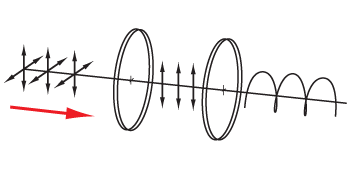
Circular polarizers can convert light with an arbitrary polarization into circularly polarized light.
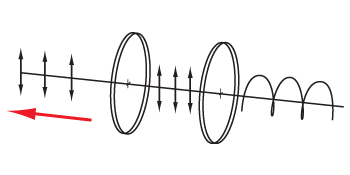
Circular polarizers can convert circularly polarized light into linearly polarized light.
Below are transmission graphs for the polymer circular polarizers. The polarized input is aligned with the transmission axis of the linear polarizing film. These transmission graphs show only transmission data; output polarization may vary if the input beam wavelength is different from the polarizer's design wavelength.
The circular polarizers are coated on each air-to-glass interface with an antireflective coating for either 350 - 700 nm (Thorlabs' -A coating), 650 - 1100 nm (Thorlabs' -B coating), or 1050 - 1700 nm (Thorlabs' -C coating). These high-performance multilayer AR coatings have an average reflectance of less than 0.5% (per surface) across the specified wavelength ranges.
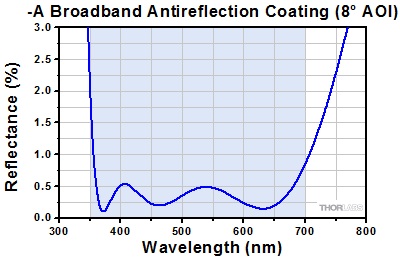
Click to Enlarge
Click Here for Raw Data
The blue shaded region indicates the specified 350 - 700 nm wavelength range for optimum performance.

Click to Enlarge
Click Here for Raw Data
The blue shaded region indicates the specified 650 - 1050 nm wavelength range for optimum performance.

Click to Enlarge
Click Here for Raw Data
The blue shaded region indicates the specified 1050 - 1700 nm wavelength range for optimum performance.
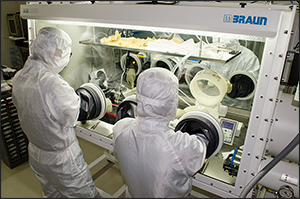
Click to Enlarge
Figure 1: Our highly trained engineers constructing and testing polymer wave plates.
Thorlabs offers a large variety of circular polarizers with operating wavelengths from 405 nm to 1550 nm. In addition, we also offer OEM and customized circular polarizers upon request. The design wavelength, coating, mechanical housing, and dimensions can be customized to meet unique application needs.
Our engineers work with our customers to discuss the specifications and other design aspects of a customized circular polarizer. We analyze the design for quality and feasibility to ensure the customized products are manufactured to meet the highest standards in a timely manner. For more information about ordering a customized polymer wave plate, please contact Technical Support.
Custom Wavelength
The design wavelength of a circular polarizer is determined by the thickness of a layer of cured, birefringent liquid crystal polymer. This layer is coated on top of the alignment material using a spin coating technique, enabling precise control of the layer’s thickness. Our standard circular polarizers cover many common wavelengths; customized wavelengths between 400 nm and 1600 nm can be specially ordered as well.
Custom Size and Mounting Options
We offer unmounted Ø1" circular polarizers from stock. Customized polarizers are available in sizes from Ø0.5" to Ø2" and can be ordered either mounted or unmounted.

Click for Details
Figure 4: The test setup for checking the retardance and alignment uniformity of our polymer wave plates.
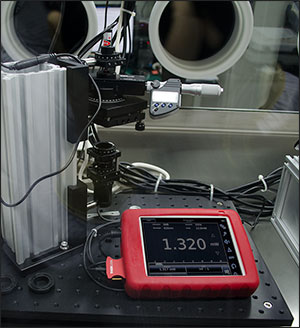
Click to Enlarge
Figure 3: The test setup for measuring the retardance through a polymer wave plate.
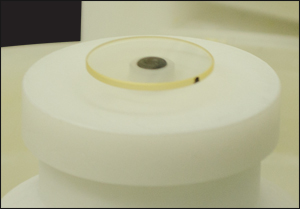
Click for Details
Figure 2: A glass substrate mounted on the spin coating machine ready to be coated with the photo alignment material.
| Design Wavelength | Damage Threshold |
|---|---|
| 405 nm, 488 nm, 532 nm, 633 nm, 670 nm | Pulsed: 0.3 J/cm2 (532 nm, 10 ns, 10 Hz, Ø0.750 mm) CW: 1 W/cm2 (532 nm, Ø0.471 mm) |
| 780 nm, 808 nm, 830 nm | Pulsed: 0.3 J/cm2 (810 nm, 10 ns, 10 Hz, Ø0.08 mm) CW: 1 W/cm2 (810 nm, Ø0.004 mm) |
| 1064 nm, 1310 nm, 1550 nm | Pulsed: 2.0 J/cm2 (1540 nm, 10 ns, 10 Hz, Ø0.242 mm) CW: 1 W/cm2 (1542 nm, Ø0.161 mm) |
Damage Threshold Data for Thorlabs' Circular Polarizers
The specifications to the right are measured data for Thorlabs' polymer circular polarizers. Damage threshold specifications are constant for all of the polarizers with the same design wavelength.
Laser Induced Damage Threshold Tutorial
The following is a general overview of how laser induced damage thresholds are measured and how the values may be utilized in determining the appropriateness of an optic for a given application. When choosing optics, it is important to understand the Laser Induced Damage Threshold (LIDT) of the optics being used. The LIDT for an optic greatly depends on the type of laser you are using. Continuous wave (CW) lasers typically cause damage from thermal effects (absorption either in the coating or in the substrate). Pulsed lasers, on the other hand, often strip electrons from the lattice structure of an optic before causing thermal damage. Note that the guideline presented here assumes room temperature operation and optics in new condition (i.e., within scratch-dig spec, surface free of contamination, etc.). Because dust or other particles on the surface of an optic can cause damage at lower thresholds, we recommend keeping surfaces clean and free of debris. For more information on cleaning optics, please see our Optics Cleaning tutorial.
Testing Method
Thorlabs' LIDT testing is done in compliance with ISO/DIS 11254 and ISO 21254 specifications.
First, a low-power/energy beam is directed to the optic under test. The optic is exposed in 10 locations to this laser beam for 30 seconds (CW) or for a number of pulses (pulse repetition frequency specified). After exposure, the optic is examined by a microscope (~100X magnification) for any visible damage. The number of locations that are damaged at a particular power/energy level is recorded. Next, the power/energy is either increased or decreased and the optic is exposed at 10 new locations. This process is repeated until damage is observed. The damage threshold is then assigned to be the highest power/energy that the optic can withstand without causing damage. A histogram such as that below represents the testing of one BB1-E02 mirror.

The photograph above is a protected aluminum-coated mirror after LIDT testing. In this particular test, it handled 0.43 J/cm2 (1064 nm, 10 ns pulse, 10 Hz, Ø1.000 mm) before damage.

| Example Test Data | |||
|---|---|---|---|
| Fluence | # of Tested Locations | Locations with Damage | Locations Without Damage |
| 1.50 J/cm2 | 10 | 0 | 10 |
| 1.75 J/cm2 | 10 | 0 | 10 |
| 2.00 J/cm2 | 10 | 0 | 10 |
| 2.25 J/cm2 | 10 | 1 | 9 |
| 3.00 J/cm2 | 10 | 1 | 9 |
| 5.00 J/cm2 | 10 | 9 | 1 |
According to the test, the damage threshold of the mirror was 2.00 J/cm2 (532 nm, 10 ns pulse, 10 Hz, Ø0.803 mm). Please keep in mind that these tests are performed on clean optics, as dirt and contamination can significantly lower the damage threshold of a component. While the test results are only representative of one coating run, Thorlabs specifies damage threshold values that account for coating variances.
Continuous Wave and Long-Pulse Lasers
When an optic is damaged by a continuous wave (CW) laser, it is usually due to the melting of the surface as a result of absorbing the laser's energy or damage to the optical coating (antireflection) [1]. Pulsed lasers with pulse lengths longer than 1 µs can be treated as CW lasers for LIDT discussions.
When pulse lengths are between 1 ns and 1 µs, laser-induced damage can occur either because of absorption or a dielectric breakdown (therefore, a user must check both CW and pulsed LIDT). Absorption is either due to an intrinsic property of the optic or due to surface irregularities; thus LIDT values are only valid for optics meeting or exceeding the surface quality specifications given by a manufacturer. While many optics can handle high power CW lasers, cemented (e.g., achromatic doublets) or highly absorptive (e.g., ND filters) optics tend to have lower CW damage thresholds. These lower thresholds are due to absorption or scattering in the cement or metal coating.

LIDT in linear power density vs. pulse length and spot size. For long pulses to CW, linear power density becomes a constant with spot size. This graph was obtained from [1].

Pulsed lasers with high pulse repetition frequencies (PRF) may behave similarly to CW beams. Unfortunately, this is highly dependent on factors such as absorption and thermal diffusivity, so there is no reliable method for determining when a high PRF laser will damage an optic due to thermal effects. For beams with a high PRF both the average and peak powers must be compared to the equivalent CW power. Additionally, for highly transparent materials, there is little to no drop in the LIDT with increasing PRF.
In order to use the specified CW damage threshold of an optic, it is necessary to know the following:
- Wavelength of your laser
- Beam diameter of your beam (1/e2)
- Approximate intensity profile of your beam (e.g., Gaussian)
- Linear power density of your beam (total power divided by 1/e2 beam diameter)
Thorlabs expresses LIDT for CW lasers as a linear power density measured in W/cm. In this regime, the LIDT given as a linear power density can be applied to any beam diameter; one does not need to compute an adjusted LIDT to adjust for changes in spot size, as demonstrated by the graph to the right. Average linear power density can be calculated using the equation below.

The calculation above assumes a uniform beam intensity profile. You must now consider hotspots in the beam or other non-uniform intensity profiles and roughly calculate a maximum power density. For reference, a Gaussian beam typically has a maximum power density that is twice that of the uniform beam (see lower right).
Now compare the maximum power density to that which is specified as the LIDT for the optic. If the optic was tested at a wavelength other than your operating wavelength, the damage threshold must be scaled appropriately. A good rule of thumb is that the damage threshold has a linear relationship with wavelength such that as you move to shorter wavelengths, the damage threshold decreases (i.e., a LIDT of 10 W/cm at 1310 nm scales to 5 W/cm at 655 nm):

While this rule of thumb provides a general trend, it is not a quantitative analysis of LIDT vs wavelength. In CW applications, for instance, damage scales more strongly with absorption in the coating and substrate, which does not necessarily scale well with wavelength. While the above procedure provides a good rule of thumb for LIDT values, please contact Tech Support if your wavelength is different from the specified LIDT wavelength. If your power density is less than the adjusted LIDT of the optic, then the optic should work for your application.
Please note that we have a buffer built in between the specified damage thresholds online and the tests which we have done, which accommodates variation between batches. Upon request, we can provide individual test information and a testing certificate. The damage analysis will be carried out on a similar optic (customer's optic will not be damaged). Testing may result in additional costs or lead times. Contact Tech Support for more information.
Pulsed Lasers
As previously stated, pulsed lasers typically induce a different type of damage to the optic than CW lasers. Pulsed lasers often do not heat the optic enough to damage it; instead, pulsed lasers produce strong electric fields capable of inducing dielectric breakdown in the material. Unfortunately, it can be very difficult to compare the LIDT specification of an optic to your laser. There are multiple regimes in which a pulsed laser can damage an optic and this is based on the laser's pulse length. The highlighted columns in the table below outline the relevant pulse lengths for our specified LIDT values.
Pulses shorter than 10-9 s cannot be compared to our specified LIDT values with much reliability. In this ultra-short-pulse regime various mechanics, such as multiphoton-avalanche ionization, take over as the predominate damage mechanism [2]. In contrast, pulses between 10-7 s and 10-4 s may cause damage to an optic either because of dielectric breakdown or thermal effects. This means that both CW and pulsed damage thresholds must be compared to the laser beam to determine whether the optic is suitable for your application.
| Pulse Duration | t < 10-9 s | 10-9 < t < 10-7 s | 10-7 < t < 10-4 s | t > 10-4 s |
|---|---|---|---|---|
| Damage Mechanism | Avalanche Ionization | Dielectric Breakdown | Dielectric Breakdown or Thermal | Thermal |
| Relevant Damage Specification | No Comparison (See Above) | Pulsed | Pulsed and CW | CW |
When comparing an LIDT specified for a pulsed laser to your laser, it is essential to know the following:

LIDT in energy density vs. pulse length and spot size. For short pulses, energy density becomes a constant with spot size. This graph was obtained from [1].
- Wavelength of your laser
- Energy density of your beam (total energy divided by 1/e2 area)
- Pulse length of your laser
- Pulse repetition frequency (prf) of your laser
- Beam diameter of your laser (1/e2 )
- Approximate intensity profile of your beam (e.g., Gaussian)
The energy density of your beam should be calculated in terms of J/cm2. The graph to the right shows why expressing the LIDT as an energy density provides the best metric for short pulse sources. In this regime, the LIDT given as an energy density can be applied to any beam diameter; one does not need to compute an adjusted LIDT to adjust for changes in spot size. This calculation assumes a uniform beam intensity profile. You must now adjust this energy density to account for hotspots or other nonuniform intensity profiles and roughly calculate a maximum energy density. For reference a Gaussian beam typically has a maximum energy density that is twice that of the 1/e2 beam.
Now compare the maximum energy density to that which is specified as the LIDT for the optic. If the optic was tested at a wavelength other than your operating wavelength, the damage threshold must be scaled appropriately [3]. A good rule of thumb is that the damage threshold has an inverse square root relationship with wavelength such that as you move to shorter wavelengths, the damage threshold decreases (i.e., a LIDT of 1 J/cm2 at 1064 nm scales to 0.7 J/cm2 at 532 nm):

You now have a wavelength-adjusted energy density, which you will use in the following step.
Beam diameter is also important to know when comparing damage thresholds. While the LIDT, when expressed in units of J/cm², scales independently of spot size; large beam sizes are more likely to illuminate a larger number of defects which can lead to greater variances in the LIDT [4]. For data presented here, a <1 mm beam size was used to measure the LIDT. For beams sizes greater than 5 mm, the LIDT (J/cm2) will not scale independently of beam diameter due to the larger size beam exposing more defects.
The pulse length must now be compensated for. The longer the pulse duration, the more energy the optic can handle. For pulse widths between 1 - 100 ns, an approximation is as follows:

Use this formula to calculate the Adjusted LIDT for an optic based on your pulse length. If your maximum energy density is less than this adjusted LIDT maximum energy density, then the optic should be suitable for your application. Keep in mind that this calculation is only used for pulses between 10-9 s and 10-7 s. For pulses between 10-7 s and 10-4 s, the CW LIDT must also be checked before deeming the optic appropriate for your application.
Please note that we have a buffer built in between the specified damage thresholds online and the tests which we have done, which accommodates variation between batches. Upon request, we can provide individual test information and a testing certificate. Contact Tech Support for more information.
[1] R. M. Wood, Optics and Laser Tech. 29, 517 (1998).
[2] Roger M. Wood, Laser-Induced Damage of Optical Materials (Institute of Physics Publishing, Philadelphia, PA, 2003).
[3] C. W. Carr et al., Phys. Rev. Lett. 91, 127402 (2003).
[4] N. Bloembergen, Appl. Opt. 12, 661 (1973).
In order to illustrate the process of determining whether a given laser system will damage an optic, a number of example calculations of laser induced damage threshold are given below. For assistance with performing similar calculations, we provide a spreadsheet calculator that can be downloaded by clicking the button to the right. To use the calculator, enter the specified LIDT value of the optic under consideration and the relevant parameters of your laser system in the green boxes. The spreadsheet will then calculate a linear power density for CW and pulsed systems, as well as an energy density value for pulsed systems. These values are used to calculate adjusted, scaled LIDT values for the optics based on accepted scaling laws. This calculator assumes a Gaussian beam profile, so a correction factor must be introduced for other beam shapes (uniform, etc.). The LIDT scaling laws are determined from empirical relationships; their accuracy is not guaranteed. Remember that absorption by optics or coatings can significantly reduce LIDT in some spectral regions. These LIDT values are not valid for ultrashort pulses less than one nanosecond in duration.

A Gaussian beam profile has about twice the maximum intensity of a uniform beam profile.
CW Laser Example
Suppose that a CW laser system at 1319 nm produces a 0.5 W Gaussian beam that has a 1/e2 diameter of 10 mm. A naive calculation of the average linear power density of this beam would yield a value of 0.5 W/cm, given by the total power divided by the beam diameter:

However, the maximum power density of a Gaussian beam is about twice the maximum power density of a uniform beam, as shown in the graph to the right. Therefore, a more accurate determination of the maximum linear power density of the system is 1 W/cm.
An AC127-030-C achromatic doublet lens has a specified CW LIDT of 350 W/cm, as tested at 1550 nm. CW damage threshold values typically scale directly with the wavelength of the laser source, so this yields an adjusted LIDT value:

The adjusted LIDT value of 350 W/cm x (1319 nm / 1550 nm) = 298 W/cm is significantly higher than the calculated maximum linear power density of the laser system, so it would be safe to use this doublet lens for this application.
Pulsed Nanosecond Laser Example: Scaling for Different Pulse Durations
Suppose that a pulsed Nd:YAG laser system is frequency tripled to produce a 10 Hz output, consisting of 2 ns output pulses at 355 nm, each with 1 J of energy, in a Gaussian beam with a 1.9 cm beam diameter (1/e2). The average energy density of each pulse is found by dividing the pulse energy by the beam area:

As described above, the maximum energy density of a Gaussian beam is about twice the average energy density. So, the maximum energy density of this beam is ~0.7 J/cm2.
The energy density of the beam can be compared to the LIDT values of 1 J/cm2 and 3.5 J/cm2 for a BB1-E01 broadband dielectric mirror and an NB1-K08 Nd:YAG laser line mirror, respectively. Both of these LIDT values, while measured at 355 nm, were determined with a 10 ns pulsed laser at 10 Hz. Therefore, an adjustment must be applied for the shorter pulse duration of the system under consideration. As described on the previous tab, LIDT values in the nanosecond pulse regime scale with the square root of the laser pulse duration:

This adjustment factor results in LIDT values of 0.45 J/cm2 for the BB1-E01 broadband mirror and 1.6 J/cm2 for the Nd:YAG laser line mirror, which are to be compared with the 0.7 J/cm2 maximum energy density of the beam. While the broadband mirror would likely be damaged by the laser, the more specialized laser line mirror is appropriate for use with this system.
Pulsed Nanosecond Laser Example: Scaling for Different Wavelengths
Suppose that a pulsed laser system emits 10 ns pulses at 2.5 Hz, each with 100 mJ of energy at 1064 nm in a 16 mm diameter beam (1/e2) that must be attenuated with a neutral density filter. For a Gaussian output, these specifications result in a maximum energy density of 0.1 J/cm2. The damage threshold of an NDUV10A Ø25 mm, OD 1.0, reflective neutral density filter is 0.05 J/cm2 for 10 ns pulses at 355 nm, while the damage threshold of the similar NE10A absorptive filter is 10 J/cm2 for 10 ns pulses at 532 nm. As described on the previous tab, the LIDT value of an optic scales with the square root of the wavelength in the nanosecond pulse regime:

This scaling gives adjusted LIDT values of 0.08 J/cm2 for the reflective filter and 14 J/cm2 for the absorptive filter. In this case, the absorptive filter is the best choice in order to avoid optical damage.
Pulsed Microsecond Laser Example
Consider a laser system that produces 1 µs pulses, each containing 150 µJ of energy at a repetition rate of 50 kHz, resulting in a relatively high duty cycle of 5%. This system falls somewhere between the regimes of CW and pulsed laser induced damage, and could potentially damage an optic by mechanisms associated with either regime. As a result, both CW and pulsed LIDT values must be compared to the properties of the laser system to ensure safe operation.
If this relatively long-pulse laser emits a Gaussian 12.7 mm diameter beam (1/e2) at 980 nm, then the resulting output has a linear power density of 5.9 W/cm and an energy density of 1.2 x 10-4 J/cm2 per pulse. This can be compared to the LIDT values for a WPQ10E-980 polymer zero-order quarter-wave plate, which are 5 W/cm for CW radiation at 810 nm and 5 J/cm2 for a 10 ns pulse at 810 nm. As before, the CW LIDT of the optic scales linearly with the laser wavelength, resulting in an adjusted CW value of 6 W/cm at 980 nm. On the other hand, the pulsed LIDT scales with the square root of the laser wavelength and the square root of the pulse duration, resulting in an adjusted value of 55 J/cm2 for a 1 µs pulse at 980 nm. The pulsed LIDT of the optic is significantly greater than the energy density of the laser pulse, so individual pulses will not damage the wave plate. However, the large average linear power density of the laser system may cause thermal damage to the optic, much like a high-power CW beam.
| Posted Comments: | |
David Maluenda
(posted 2023-05-11 11:00:22.937) Hi. I am wondering if the retardance plate is a zero-order quarter wave plater or a multi-order, because I would like to use a circular polarizer intended for 532nm with a laser of a 514nm. Then, the error in the retardance would be about 10%, right?
Thanks. jdelia
(posted 2023-05-18 11:59:04.0) Thank you for contacting Thorlabs. Our circular polarizers consist of a linear polarizing film and a polymer quarter-wave film, where the polymer quarter-wave film is true zero-order. When using circular polarizers at the designed wavelength, the ellipticity of the output light is >43.5°. When using a 532 nm circular polarizer at 514 nm, the ellipticity will be just >41.4°. We can offer custom wavelength circular polarizers if the category items don't meet your laser specifications. user
(posted 2022-12-08 17:20:33.317) wish to know if this product can be designed for a wide working bandwidth,like 1550nm±50nm? cdolbashian
(posted 2022-12-15 01:33:00.0) Thank you for contacting Thorlabs. The design wavelength of a circular polarizer is determined by the thickness of a layer of cured, birefringent liquid crystal polymer. A broadband version is not feasible. In your case, the theoretical ellipticity at 1500-1600nm can drop by about 2deg from the rated value of >43.5deg. user
(posted 2021-02-28 20:57:00.14) I'd like to request wavelength vs. retardance data for the CPL1L532/CPL1R532 products. I'm especially interested in the wavelength range between 560 and 580 nm. asundararaj
(posted 2021-03-02 09:31:33.0) Thank you for contacting Thorlabs. The quarter-wave film being used in CP1L532 provides a retardance accuracy of <λ/100. For retardance at a different wavelength, it would be safe to take a proportional ratio to the inverse of the wavelength. Please note that this calculation does not taken into account dispersion of the polarizing film. Ana R
(posted 2021-01-28 12:13:28.173) Would you be able to make a 780 nm RHC polariser with a 0.5" diameter? YLohia
(posted 2021-01-28 10:29:53.0) Thank you for contacting Thorlabs. Custom optics can be requested by using the "Request Quote" button above or by contacting your local Thorlabs Tech Support Team. We will reach out to you directly to discuss the possibility of offering this. Robert Watson
(posted 2020-05-15 10:15:13.63) Is the step model correct, seems to be 1.6mm thick not 3.5mm as per pdf drawing? YLohia
(posted 2020-05-18 09:09:56.0) Thank you for your feedback and bringing this to our attention. The step file is incorrrect and we are working on fixing it. user
(posted 2020-01-17 16:17:38.653) Dear Thorlabs,
I am using your circular polarizer CP1R633 to obtain circular polarization from a HeNe laser. When analyzing the light after the CP with a rotating polarizer (tested various polarizers for that wavelength) I get a modulation in the order of +/- 10%.
Doing the math on your ellipticity number (>43.5°), I get a minimum axis ratio of 0.949. Assuming this is the electric field ratio, I square this to obtain 0.901 for the intensity ratio.
Is my calculation correct? Does that mean a residual linear polarization of 10 % is a reasonable value? Or is there something wrong with the waveplate?
(I measured this with various optical components and consistently ended up with similar values.) MKiess
(posted 2020-01-30 07:52:24.0) This is a response from Michael at Thorlabs. Thank you very much for your feedback on CP1R633, your measurement is reasonable. I have contacted you directly to further discuss the measurement. Chunyang Han
(posted 2019-12-09 11:35:35.937) 我想咨询下你们这款聚合物圆偏振片能不能定制,具体参数如下:
1. 波长为1550nm
2.尺寸为:5mm*5mm正方形
3. 输出偏振态:右旋光 nbayconich
(posted 2019-12-10 10:41:49.0) Thank you for contacting Thorlabs. We will reach out to you directly to discuss your custom request. For future custom requests, please contact us at techsupport@thorlabs.com. Volkmar Schultze
(posted 2019-04-04 05:18:04.353) Hello Thorlab, I wonder if I can use the polarizer CP1L830 also at a wavelength of 894 nm. The refectance looks goos, but how good is the circular polarization at this wavelength? nbayconich
(posted 2019-04-04 02:35:45.0) Thank you for contacting Thorlabs. You can use these circular polarizers outside of the design wavelength however the retardance of the waveplate will not produce exactly a quarter wave. You can refer to the WPQ10E-830 polymer waveplate retardance vs. wavelength data below.
https://www.thorlabs.com/images/popupImages/WPQ10E-830_RawData_ext.xlsx
I would expect the retardance at 894nm to be about 0.2296 waves. christian.schmidt
(posted 2019-01-09 09:01:35.64) Hello Thorlabs-team, this is a nice product. I am intrested in a costume wavelength design for 895 nm. Is it this possible and how high is the relectance of an incidence beam from the polarizer side? Thank you very much. Christian nbayconich
(posted 2019-01-22 09:28:46.0) Thank you for contacting Thorlabs. We can make a custom 895nm circular polarizer. I will reach out to you directly to share some reflectance data we have gathered for these polarizers. |


At a given position along the optical axis, the electric field of a left-handed circularly polarized beam rotates
Left-handed circular polarizers will convert a beam with an arbitrary polarization state into a left-handed circularly polarized beam, provided that the input beam is not polarized perpendicular to the linear polarizing film inside. The input surface and transmission axis of the polarizing film is marked by an arrow on the edge of the circular polarizer.
Alternatively, these polarizers can convert left-handed circularly polarized light into linearly polarized light. The arrow marking on the edge of the optic points in the direction of transmission for this application. If right-handed circularly polarized light is incident on the polarizer in this direction, the transmission through the optic will be zero.
These polarizers define the direction of circular polarization as viewed from the light source looking along the optical axis in the direction of propagation. "Left-handed" circular polarization refers to the counter-clockwise rotation of the electric field over time, at a fixed point on the optical axis. See the image to the right for a visual representation.
| Item # | CP1L405 | CP1L488 | CP1L532 | CP1L633 | CP1L670 | CP1L780 | CP1L808 | CP1L830 | CP1L1064 | CP1L1310 | CP1L1550 | |
|---|---|---|---|---|---|---|---|---|---|---|---|---|
| Design Wavelength | 405 nm | 488 nm | 532 nm | 633 nm | 670 nm | 780 nm | 808 nm | 830 nm | 1064 nm | 1310 nm | 1550 nm | |
| AR Coating Range | Ravg < 0.5% per Surface for 350 - 700 nm | Ravg < 0.5% per Surface for 650 - 1050 nm |
Ravg < 0.5% per Surface for 1050 - 1700 nm | |||||||||
| Damage Threshold | Pulsed | 0.3 J/cm2 (532 nm, 10 ns, 10 Hz, Ø0.750 mm) | 0.3 J/cm2 (810 nm, 10 ns, 10 Hz, Ø0.08 mm) | 2.0 J/cm2 (1540 nm, 10 ns, 10 Hz, Ø242 µm) | ||||||||
| CW | 1 W/cm2 (532 nm, Ø0.471 mm) | 1 W/cm2 (810 nm, Ø0.004 mm) | 1 W/cm2 (1542 nm, Ø0.161 mm) | |||||||||
| Transmission (Click for Graph) |
Raw Data |
Raw Data |
Raw Data |
|||||||||
| Transmitted Wavefront Distortion | λ/4 at 633 nm | 3λ/2 at 633 nm | λ/4 at 633 nm | |||||||||

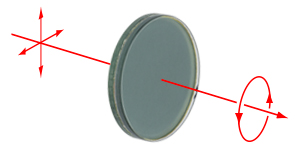
At a given position along the optical axis, the electric field of a right-handed circularly polarized beam rotates clockwise as viewed from the light source.
Right-handed circular polarizers will convert a beam with an arbitrary polarization state into a right-handed circularly polarized beam, provided that the input beam is not polarized perpendicular to the linear polarizing film inside. The input surface and transmission axis of the polarizing film is marked by an arrow on the edge of the circular polarizer.
Alternatively, these polarizers can convert right-handed circularly polarized light into linearly polarized light. The arrow marking on the edge of the optic points in the direction of transmission for this application. If left-handed circularly polarized light is incident on the polarizer in this direction, the transmission through the optic will be zero.
These polarizers define the direction of circular polarization as viewed from the light source looking along the optical axis in the direction of propagation. "Right-handed" circular polarization refers to the clockwise rotation of the electric field over time, at a fixed point on the optical axis. See the image to the right for a visual representation.
| Item # | CP1R405 | CP1R488 | CP1R532 | CP1R633 | CP1R670 | CP1R780 | CP1R808 | CP1R830 | CP1R1064 | CP1R1310 | CP1R1550 | |
|---|---|---|---|---|---|---|---|---|---|---|---|---|
| Design Wavelength | 405 nm | 488 nm | 532 nm | 633 nm | 670 nm | 780 nm | 808 nm | 830 nm | 1064 nm | 1310 nm | 1550 nm | |
| AR Coating Range | Ravg < 0.5% per Surface for 350 - 700 nm | Ravg < 0.5% per Surface for 650 - 1050 nm |
Ravg < 0.5% per Surface for 1050 - 1700 nm | |||||||||
| Damage Threshold | Pulsed | 0.3 J/cm2 (532 nm, 10 ns, 10 Hz, Ø0.750 mm) | 0.3 J/cm2 (810 nm, 10 ns, 10 Hz, Ø0.08 mm) | 2.0 J/cm2 (1540 nm, 10 ns, 10 Hz, Ø242 µm) | ||||||||
| CW | 1 W/cm2 (532 nm, Ø0.471 mm) | 1 W/cm2 (810 nm, Ø0.004 mm) | 1 W/cm2 (1542 nm, Ø0.161 mm) | |||||||||
| Transmission (Click for Graph) |
Raw Data |
Raw Data |
Raw Data |
|||||||||
| Transmitted Wavefront Distortion | λ/4 at 633 nm | 3λ/2 at 633 nm | λ/4 at 633 nm | |||||||||
 Products Home
Products Home







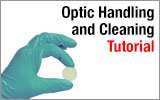
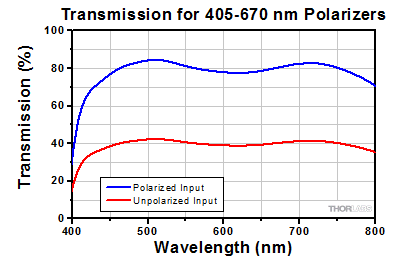
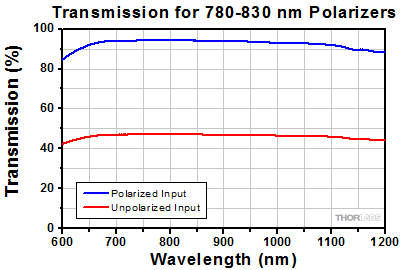


 Polymer Circular Polarizers
Polymer Circular Polarizers